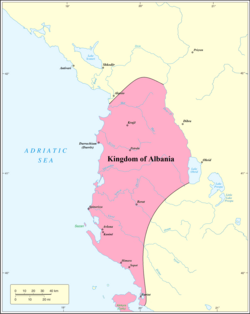Kingdom of Albania (medieval)
| Kingdom of Albania | ||||||||||||
|
Regnum Albaniae (Latin) Mbretëria e Arbërisë (Albanian) |
||||||||||||
| Personal Union with the Angevin Kingdom of Sicily/Naples | ||||||||||||
|
||||||||||||
|
Kingdom of Albania at its maximum extent
|
||||||||||||
| Capital | Dyrrhachium (Durazzo) modern (Durrës) | |||||||||||
| Languages | Albanian | |||||||||||
| Religion | Catholicism, Eastern Orthodoxy | |||||||||||
| Government | Monarchy | |||||||||||
| King, Lord and later Duke | ||||||||||||
| • | 1272–1285 | Charles I | ||||||||||
| • | 1366–1368 | Louis | ||||||||||
| Historical era | Medieval | |||||||||||
| • | Established | 1272 | ||||||||||
| • | Disestablished | 1368 | ||||||||||
|
||||||||||||
| Today part of | ||||||||||||

Coat of arms of the Angevin dynasty
∟![]() Greece
Greece
The Kingdom of Albania (Albanian: Mbretëria e Arbërisë, Latin: Regnum Albaniae) was established by Albanian Nobles and Charles of Anjou in the Albanian territories conquered from the Byzantine Empire in 1271. The Kingdom of Albania was declared on february the 1st 1272. The kingdom extended from the region of Durazzo (Dyrrhachium, modern Durrës) south along the coast to Butrint. A major attempt to advance further in direction of Constantinople failed at the Siege of Berat (1280–1281). A Byzantine counteroffensive soon ensued, which drove the Albanian-Angevins out of the interior by 1281. The Sicilian Vespers further weakened the position of Charles, and the Kingdom was soon reduced by the Byzantines to a small area around Durazzo. The Angevins held out here, however, until 1368, when the city was captured by Karl Thopia. In 1392 Karl Thopia's son surrendered the city and his domains to the Republic of Venice.
...
Wikipedia

